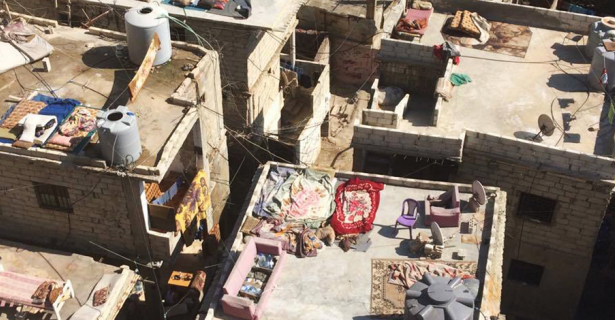They call Shatila a camp, but in reality it’s much more of a sprawling neighborhood. Infamous for the Sabra and Shatila massacre of 1982, the “camp” now plays home to far more Syrians than Palestinians. Fleeing from neighboring Syria, over 1.5 million have sought refuge in Lebanon, a country with a population of just four million. The “camp” is on the airport road, south of Beirut toward the suburbs of Dahiya, which are notorious for their pro-Hezbollah sympathies. It’s only a few minutes from Beirut proper, but it looks a world away; the women all wear full length abayas and hijabs. Electricity wires hang heavy between the buildings, braided into thick ropes, and every few feet people call out, their words varying from polite expressions of welcome to light cat calling. I can walk around downtown Beirut in a sun dress and barely get a second glance; here, even in the 90-degree weather, I always wear jeans or a full-length skirt.
The office of the NGO where I work, Basmah and Zeitoonah, is a straight shot from the entrance. In my usual routine, I get out of the service taxi at the bridge, and turn down the constantly flooded main street, dodging the cars and motorcycles as they inch along the one-way road that carts laden with fruits, vegetables, and other goods render too narrow. I glance at the shops I pass—the mounds of baklava piled high in the sweet shop, the carcasses hanging, pink and white muscles, from the butcher’s window, the ancient singer sewing machine propped on a table in the tailor’s shop—but never linger for long, keeping my gaze straight ahead as I continue on my route, studiously avoiding eye contact. When I leave the office, the routine is the same; the vendors and customers coming and going, shouting, speeding, and staring, but the street always the same.
I don’t venture into the side streets. The alleys—they can hardly be called streets—wind and turn with no discernable logic. The entire geography of Shatila has sprung up organically, each passageway and building cropping up out of need, with little thought to coordination or central planning. It is a maze not only in its physical geography, but also in its human element. One block will be papered with the face of Nasrallah, head of Hezbollah, with every window of the parallel street sporting the characteristic green logo of the competing Harikat Amel; turn the corner, and suddenly you’re in PFLP territory. Sometimes the changes are subtle; sometimes impossible to ignore. Everywhere, however, foreigners are a rare sight. I never feel unsafe in my walk to work, but I stick to my prescribed route, and despite curious glances down side streets, know better than to venture alone into the heart of the camp.
The other day, however, as I finished lunch, two of the women from my office offered to take me on their rounds. They work in the small loan department, which runs a program that offers microloans to camp residents so that they can start businesses, such as tailoring enterprises or small corner shops. That day was the six-month mark since the start of the current cycle, the day prescribed to visit the participants and check in on their progress. The two women donned khaki vests with “Basmah and Zeitoonah” embroidered in Arabic, and the three of us set out. I followed blindly through the twists and turns of Shatila, down alleyways covered with garbage and reeking of refuse, finding myself suddenly walking down the wide, open thoroughfare of a souk. We climbed flights upon flights of naked concrete stairs, knocked on doors and hastily took off our shoes as we entered apartment after apartment. Each family offered us coffee, juice, or sweets, and we sat on cushions or chairs as my coworkers asked about their health, their families, their businesses, and what, if anything, they needed. For three hours, we toured the camp, my coworkers navigating the nooks and crannies with familiarity and ease. By the time we finished the visits, I had lost all sense of bearings and rounded the corner onto the main road expecting another dead end filled with bundles of electrical wires and waste. Instead, I was back in front of the sweet shop, and the carefully crafted piles of baklava. We returned to the office, the women dropped off their notes, took off their vests, and began writing up their reports. I thanked them, drank a coffee, and headed home; down the five flights of stairs, along the main road, and back to the entrance.

